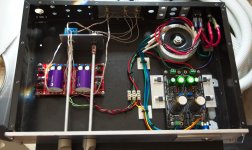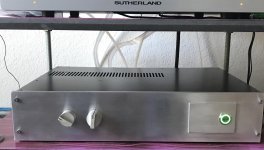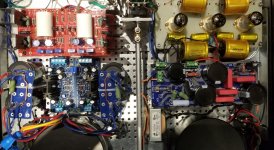So everything is working great with my BA-3 preamp build I have about 15 hours on it running at 90%. Going to let it burn in a little longer for I bias it up.
So a little background before the BA-3 I have been using a Hagerman Clarinet tube pre and before that the Mesmerize B1 and the B1 buffer before that. The Hagerman was the clear winner over the other two. I was the BA-3 and the Hagerman after I get more hours on the BA-3. So on to the BA-3, my initial impression was it was a little rough at first somewhat on the bright side my source was CD's I start there before I switch over to vinyl. It only took a few hours of burn-in it started to settle in and that brightness calmed down, Been listening to a mixture of different music genres Vocal, Jazz, Rock, Acoustic, mostly everything now on vinyl. I have to say I am really impressed with is so far tight bass, wide sound stage, and dead quiet one thing I didn't get from the tube pre there always a slight low hum. (tube gear right) Big thanks to everyone who put everything together to make this build possible and for all the help along the way.


So a little background before the BA-3 I have been using a Hagerman Clarinet tube pre and before that the Mesmerize B1 and the B1 buffer before that. The Hagerman was the clear winner over the other two. I was the BA-3 and the Hagerman after I get more hours on the BA-3. So on to the BA-3, my initial impression was it was a little rough at first somewhat on the bright side my source was CD's I start there before I switch over to vinyl. It only took a few hours of burn-in it started to settle in and that brightness calmed down, Been listening to a mixture of different music genres Vocal, Jazz, Rock, Acoustic, mostly everything now on vinyl. I have to say I am really impressed with is so far tight bass, wide sound stage, and dead quiet one thing I didn't get from the tube pre there always a slight low hum. (tube gear right) Big thanks to everyone who put everything together to make this build possible and for all the help along the way.



Thanks for the build guide 6L6.
I built my BA-3 line stage using Dale RN60 resistors with Solen output capacitors.
I put it in a cabinet set up for a previous less-than-successful project- a Chinese JC-2 preamp kit. Despite subbing in NOS Toshiba 2SK170/2SJ74s, it never sounded good.
I had a Chinese kit built Kubota supply that I used for the +/-24V supplies. If the Kubota had been unsucessful, I would have tried an AMB Labs Sigma 22 kit.
The BA-3 is easily the nicest sounding solid state preamp that I have built. It has a warm tubelike quality, but is also fast and detailed. It lacks the huge sense of depth you get from a tube preamp, but I find it pleasant enough that I could live with it if the world ever runs out of tubes. It was well worth the low cost and modest effort that it took to make.
I built my BA-3 line stage using Dale RN60 resistors with Solen output capacitors.
I put it in a cabinet set up for a previous less-than-successful project- a Chinese JC-2 preamp kit. Despite subbing in NOS Toshiba 2SK170/2SJ74s, it never sounded good.
I had a Chinese kit built Kubota supply that I used for the +/-24V supplies. If the Kubota had been unsucessful, I would have tried an AMB Labs Sigma 22 kit.
The BA-3 is easily the nicest sounding solid state preamp that I have built. It has a warm tubelike quality, but is also fast and detailed. It lacks the huge sense of depth you get from a tube preamp, but I find it pleasant enough that I could live with it if the world ever runs out of tubes. It was well worth the low cost and modest effort that it took to make.
Thanks for the build guide 6L6.
I built my BA-3 line stage using Dale RN60 resistors with Solen output capacitors.
I put it in a cabinet set up for a previous less-than-successful project- a Chinese JC-2 preamp kit. Despite subbing in NOS Toshiba 2SK170/2SJ74s, it never sounded good.
I had a Chinese kit built Kubota supply that I used for the +/-24V supplies. If the Kubota had been unsucessful, I would have tried an AMB Labs Sigma 22 kit.
The BA-3 is easily the nicest sounding solid state preamp that I have built. It has a warm tubelike quality, but is also fast and detailed. It lacks the huge sense of depth you get from a tube preamp, but I find it pleasant enough that I could live with it if the world ever runs out of tubes. It was well worth the low cost and modest effort that it took to make.
Robert,
Good work, and how have you set H2 / H3? It definitely makes a difference. Although it may never sound like a tube pre, it will have better resolution and be close with the right combination of H2/H3.
Cheers,
Greg
The datasheets linked in post #1732 include standard capacitor values, right on page 1. I've screengrabbed the relevant portions below.
But diyAudio builders typically worship at the altar named If Some Is Good Then More Is Better.
So diyAudio builders typically install much greater capacitors than the IC manufacturer says is necessary. Builders rhythmically chant More Is Better, More Is Better, More is Better as they install whopping great capacitors.
How much more? Look at the schematics of the Pearl2 phonostage here on this site. Look at the schematics of the H2 generator board here on this site. I think you'll conclude: a lot more. A LOT more.
It wouldn't raise any eyebrows on diyAudio, if someone decided to make Cin = Cout because that means you only purchase one part type ("BOM line item minimization" !) and then use it twice. It also wouldn't raise any eyebrows on diyAudio, if someone chose the capacitance value using this demonic, profligate, diabolical equation
Capacitance = 10 microfarads per milliamp
Thus if the maximum current the circuitry can possibly draw under worst-case conditions is 71 milliamps, they would purchase (10 x 71) = 710 microfarad capacitors. Actually, Mouser doesn't sell that value; the next largest E6 standard capacitance value is 820 microfarads. Thus Cin = Cout = 820 microfarads to support a worst case load of 71 milliamps will not raise eyebrows. Or at least, that's what I predict.
Is it necessary? Of course not. It is intentional, deliberate, wretched excess. Which diyAudio just loves.
_
This is coming together, I should be ready to apply power and test tomorrow. The SMD soldering seems to have worked based on multimeter checks, but we'll see. The regs are putting out +14.95 and -15.16VDC.
This has been more labor intensive than I thought, but enjoyable.
Increase R13. 600ohms would give you close to 2x the gain. (which is only 3db, but if you want a bit more, try it.)
I’m about to do the same thing for my F4. After changing R13, does the whole preamp need to be re-biased?
The Muses 224 step volume control with remote is done and working beautifully in my BA-3. Quite a step up from the eBay stepped attenuator. If you aren't afraid of some SMD work I highly recommend one. Thanks for the help with the voltage regulator.
Perhaps you mentioned it earlier but where did you get it from?
Thanks. Nash
Perhaps you mentioned it earlier but where did you get it from?
Thanks. Nash
Meldano has the boards and controller chips, PM him.
Hi,
I'm using ba-3 preamp for a while with F5. I have other amps and receivers and I gave them a listen time to time. I always felt ba3 is too sharp in the upper treble area. Cymbals don't have a variable tones, they sounds like constant, bit of metalic.
My bias&offset is rock steady, using fairchild mosfets and don't have something to analyze harmonics so I cannot measure anything. P3 is in the middle position.
Any idea what needs to be checked?
Another question, can I totally remove p3 pots?
I'm using ba-3 preamp for a while with F5. I have other amps and receivers and I gave them a listen time to time. I always felt ba3 is too sharp in the upper treble area. Cymbals don't have a variable tones, they sounds like constant, bit of metalic.
My bias&offset is rock steady, using fairchild mosfets and don't have something to analyze harmonics so I cannot measure anything. P3 is in the middle position.
Any idea what needs to be checked?
Another question, can I totally remove p3 pots?
Hi,
I'm using ba-3 preamp for a while with F5. I have other amps and receivers and I gave them a listen time to time. I always felt ba3 is too sharp in the upper treble area. Cymbals don't have a variable tones, they sounds like constant, bit of metalic.
My bias&offset is rock steady, using fairchild mosfets and don't have something to analyze harmonics so I cannot measure anything. P3 is in the middle position.
Any idea what needs to be checked?
Another question, can I totally remove p3 pots?
What kind of JFETs do you have in it?
What kind of JFETs do you have in it?
Toshiba k170&j74. Idss was around 9mA if I remember correct.
- Home
- Amplifiers
- Pass Labs
- The BA-3 as preamp build guide

